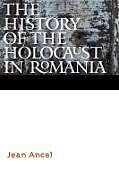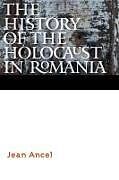The History of the Holocaust in Romania
Einband:
Fester Einband
EAN:
9780803220645
Untertitel:
Englisch
Genre:
Geschichte
Autor:
Jean Ancel
Herausgeber:
Nebraska
Anzahl Seiten:
720
Erscheinungsdatum:
01.01.2012
ISBN:
978-0-8032-2064-5
Informationen zum Autor Jean Ancel (19402008) was a Romanian-born Israeli independent historian and a research associate of Yad Vashem's International Institute for Holocaust Research. He is the author and editor of numerous books, including The Economic Destruction of Romanian Jewry (Yad Vashem, 2007), Prelude to Mass Murder: The Pogrom in Iisi, Romania, June 28 and Thereafter (Yad Vashem, 2014), and Resisting the Storm: Romania, 19401947: Memoirs. Klappentext Published by the University of Nebraska Press! Lincoln! and Yad Vashem! Jerusalem Based on an unparalleled and exhaustive collection of original Jewish accounts and sources not available until the fall of Nicolae Ceausescu in the late 1980s! Jean Ancel provides a detailed analysis of the path of anti-Semitism that led to the unspeakable horrors of the Holocaust in Romania.The Romanians! and other nations inside and outside the Balkans! related differently to "their Jews" and "other Jews!" that is! those living in districts annexed to Romania after the First World War and in areas occupied and annexed to the Romanian military administration after the Soviet invasion in June 1941. The Jews of the Regat! the core Romanian principality! suffered pogroms! decrees! and degradation! but on the whole they survived the Holocaust. Contradicting long-held assumptions! Ancel shows that Romanians were largely responsible for murdering their Jewish community--one of the largest in Europe before the war--and although its survival rate was the highest in Europe! the survival rate in areas where Jews were liquidated was one of the lowest. Zusammenfassung Provides a detailed analysis of the path of anti-Semitism that led to the unspeakable horrors of the Holocaust in Romania Inhaltsverzeichnis List of IllustrationsForeword to the Hebrew EditionEditors' NoteIntroduction1. The Goga Government: Europe's Second Antisemitic Government, 28 December 1937-10 February 19382. King Carol II's Dictatorship and Its Policy toward the Jews, February 1938-August 19403. The Rhinocerization of the Romanian Intelligentsia4. The Romanian Orthodox Church and Its Attitude toward the "Jewish Problem"5. The Nazi Influence on Romanian Political Life and Its Effect on the Situation of the Jews6. Pogroms and Persecutions in the Summer of 19407. The National-Legionary State8. Romanization9. Legionary Terror10. The Confrontation between Antonescu and the Legionnaires and Its Impact on the Situation of the Jews11. The Legionnaires' Rebellion and the Bucharest Pogrom, 21-23 January 194112. The Jewish Leadership under the National-Legionary Regime13. The Political and Ideological Foundations of the Antonescu Regime14. The Government's Attitude toward the Jews15. Romanization (II)16. The Antonescu Regime and the Final Solution, 1941-4217. The Romanian Solution to the Jewish Problem in Bessarabia and Bukovina, June-July 194118. The Camps and Ghettos in Bessarabia and Northern Bukovina, September-November 194119. The Kishinev Ghetto20. Czernowitz21. Southern Bukovina22. The Dorohoi District23. The National Bank of Romania24. Transnistria under Romanian Occupation25. The Arrest and Deportation of Jews in Transnistria26. "The Kingdom of Death"27. Odessa28. The Berezovka District29. The Typhus Epidemic30. The Hunt for Residents of Jewish Blood31. The Romanian Church and the Christianization Campaign32. The Degradation of Judaism and Jews33. The Iasi Pogrom, 29 June 194134. The Antonescu Regime and the Final Solution in the Regat and Southern Transylvania35. Toward the Implementation of the Final Solution36. The Postponement of the Nazi Final Solution37. The Jews of the Regat and Southern Transylvania in the Shadow of the Final Solution38. Statistical Data on the Holocaust in RomaniaNotesBibliographyIndex...
Autorentext
Jean Ancel (1940–2008) was a Romanian-born Israeli independent historian and a research associate of Yad Vashem’s International Institute for Holocaust Research. He is the author and editor of numerous books, including The Economic Destruction of Romanian Jewry (Yad Vashem, 2007), Prelude to Mass Murder: The Pogrom in Iisi, Romania, June 28 and Thereafter (Yad Vashem, 2014), and Resisting the Storm: Romania, 1940–1947: Memoirs.
Klappentext
Published by the University of Nebraska Press, Lincoln, and Yad Vashem, Jerusalem
Based on an unparalleled and exhaustive collection of original Jewish accounts and sources not available until the fall of Nicolae Ceausescu in the late 1980s, Jean Ancel provides a detailed analysis of the path of anti-Semitism that led to the unspeakable horrors of the Holocaust in Romania.The Romanians, and other nations inside and outside the Balkans, related differently to "their Jews" and "other Jews," that is, those living in districts annexed to Romania after the First World War and in areas occupied and annexed to the Romanian military administration after the Soviet invasion in June 1941. The Jews of the Regat, the core Romanian principality, suffered pogroms, decrees, and degradation, but on the whole they survived the Holocaust. Contradicting long-held assumptions, Ancel shows that Romanians were largely responsible for murdering their Jewish community--one of the largest in Europe before the war--and although its survival rate was the highest in Europe, the survival rate in areas where Jews were liquidated was one of the lowest.
Zusammenfassung
Provides a detailed analysis of the path of anti-Semitism that led to the unspeakable horrors of the Holocaust in Romania
Inhalt
List of IllustrationsForeword to the Hebrew EditionEditors' NoteIntroduction1. The Goga Government: Europe's Second Antisemitic Government, 28 December 1937-10 February 19382. King Carol II's Dictatorship and Its Policy toward the Jews, February 1938-August 19403. The Rhinocerization of the Romanian Intelligentsia4. The Romanian Orthodox Church and Its Attitude toward the "Jewish Problem"5. The Nazi Influence on Romanian Political Life and Its Effect on the Situation of the Jews6. Pogroms and Persecutions in the Summer of 19407. The National-Legionary State8. Romanization9. Legionary Terror10. The Confrontation between Antonescu and the Legionnaires and Its Impact on the Situation of the Jews11. The Legionnaires' Rebellion and the Bucharest Pogrom, 21-23 January 194112. The Jewish Leadership under the National-Legionary Regime13. The Political and Ideological Foundations of the Antonescu Regime14. The Government's Attitude toward the Jews15. Romanization (II)16. The Antonescu Regime and the Final Solution, 1941-4217. The Romanian Solution to the Jewish Problem in Bessarabia and Bukovina, June-July 194118. The Camps and Ghettos in Bessarabia and Northern Bukovina, September-November 194119. The Kishinev Ghetto20. Czernowitz21. Southern Bukovina22. The Dorohoi District23. The National Bank of Romania24. Transnistria under Romanian Occupation25. The Arrest and Deportation of Jews in Transnistria26. "The Kingdom of Death"27. Odessa28. The Berezovka District29. The Typhus Epidemic30. The Hunt for Residents of Jewish Blood31. The Romanian Church and the Christianization Campaign32. The Degradation of Judaism and Jews33. The Iasi Pogrom, 29 June 194134. The Antonescu Regime and the Final Solution in the Regat and Southern Transylvania35. Toward the Implementation of the Final Solution36. The Postponement of the Nazi Final Solution37. The Jews of the Regat and Southern Transylvania in the Shadow of the Final Solution38. Statistical Data on the Holocaust in RomaniaNote…

Leider konnten wir für diesen Artikel keine Preise ermitteln ...
billigbuch.ch sucht jetzt für Sie die besten Angebote ...
Die aktuellen Verkaufspreise von 6 Onlineshops werden in Realtime abgefragt.
Sie können das gewünschte Produkt anschliessend direkt beim Anbieter Ihrer Wahl bestellen.
Loading...
Die aktuellen Verkaufspreise von 6 Onlineshops werden in Realtime abgefragt.
Sie können das gewünschte Produkt anschliessend direkt beim Anbieter Ihrer Wahl bestellen.
| # | Onlineshop | Preis CHF | Versand CHF | Total CHF | ||
|---|---|---|---|---|---|---|
| 1 | Seller | 0.00 | 0.00 | 0.00 |
